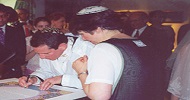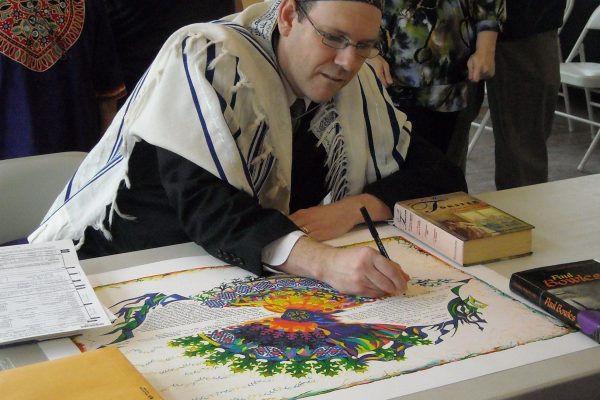The ketubah, or marriage contract, was created in the 1st century CE to protect the woman in marriage. The document spelled out the husband’s obligations in marriage (the wife’s were assumed) and provided for a financial settlement for her in the event of divorce. It is not a contract between equals, but a statement, signed by witnesses, that the groom “acquired” the bride “with two hundred silver zuzim, which is due you according to the Torah law…” on such and such a date and agrees to support her. For its time, it was an incredibly progressive document—a man could no longer discard his wife on a whim, leaving her financially bereft.
However, the world has changed a lot in 2,000 years and what was once progressive has become regressive. The traditional ketubah hardly reflects the egalitarian vision of marriage most couples share. Changing it, however, is complex. Many people feel attached to the ancient language of the traditional ketubah (it is written in Aramaic) and others feel strongly that their ketubah be acceptable within the boundaries of halakhah (Jewish law). Lastly, despite advances, we do not live in an egalitarian world. Women are still in need of greater protection, particularly in the realm of Jewish divorce where a recalcitrant husband can refuse to give his wife a get (divorce), leaving her unable to remarry.
Contemporary Solutions
- New Ketubot, New Language – Many new ketubot dispense with the traditional language altogether. Written in Hebrew or English, they focus on the hopes and aspirations of the couple. Some couples write these documents themselves; today, many versions are widely available for purchase. This solution has the advantage of being personal and of moving away from the legal and financial aspects of the traditional ketubah, which some couples see as inappropriate on the day of their wedding. Others feel that the wisdom of the ancient rabbis remains good counsel—marriage is, after all, a legal and financial arrangement, among other things, and at such a heady, dream-like moment in one’s life, a grounding in reality can be useful. Also, rabbinic officiants’ views can be a factor—e.g. traditional Conservative and Orthodox rabbis will not use an alternative ketubah. Check with your rabbi first.
- Egalitarian Ketubot – Some people have chosen to maintain the traditional language of the ketubah, but rewrite it to reflect the egalitarian nature of the marriage. There are precedents for such language in ancient ketubot from Palestine (the text traditionally used was authored in Babylon). Some couples make the traditional language of the ketubah egalitarian; others enumerate more specific obligations, such as a shared commitment to living in Israel or shared responsibility for future children.
- Lovers’ Covenant – Rachel Adler, a Jewish feminist theologian, makes a powerful argument against the traditional Jewish wedding, specifically kiddushin, in her book Engendering Judaism. Doing away with the traditional acquisition of the bride by the groom (kinyan), she offers in its place a model of partnership based on ancient partnership agreements and on the eternal covenant between God and the Jewish people. She calls her ritual B’rit Ahuvim; rather than a traditional ketubah, there is a shtar or contract that specifies the obligations of this new partnership.
- Divorce – Although many couples would prefer not to deal with the possibility of divorce at the time of their wedding, in fact, the traditional ketubah does just that. Given the egregious situation of the agunah (“chained” woman who cannot remarry because her husband refuses a divorce), Orthodox couples often sign a pre-nuptial agreement in which the parties agree to submit to the authority of a bet din (religious court) in the event of a divorce. Conservative couples either include this language within the ketubah itself (Lieberman clause) or use a Conservative pre-nuptial agreement.
- A Beautiful Ketubah – In the 1940’s and 50’s, the ketubah, if there was one, was usually an unembellished, typed form, signed and stored away with other legal documents. In the last thirty years, the ancient art of illumination has returned to the ketubah. Some couples commission a calligrapher to create a unique ketubah for them, often incorporating ideas or symbols special to them in the design of the ketubah. Many beautiful lithographs are also available for a fraction of the cost; a calligrapher can be paid a nominal fee to write in the relevant information (date, place, names) to conform with the rest of the text.












